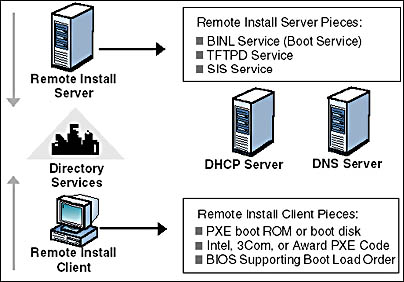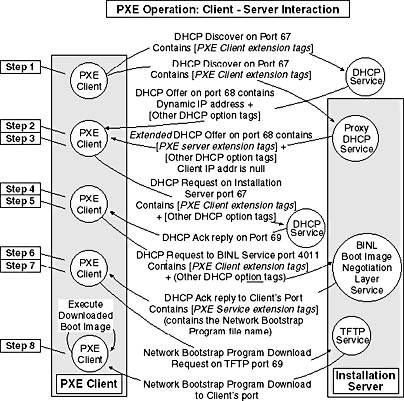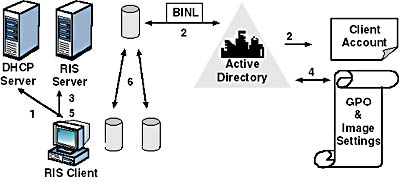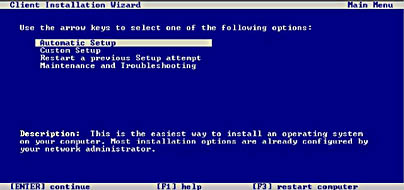Lesson 5: Remote Installation Services Overview
RIS was discussed briefly in Chapter 1, Installing Windows 2000 Professional. This lesson and the lessons that follow provide a more detailed look at RIS.
This lesson starts with an overview of the RIS architecture and components and the Microsoft Windows 2000 services that are required to take advantage of the Remote OS Installation feature. This lesson also describes the client components and services that are required to implement Remote OS Installation in your organization.
After this lesson, you will be able to
- Identify the services and components that make up the Remote OS Installation feature
- Explain how the Remote OS Installation process works
- Identify RIS server and client requirements
- Identify network cards supported by RIS boot disk
Estimated lesson time: 20 minutes
Remote OS Installation Overview
Figure 20.20 illustrates the services and components that make up the Remote OS Installation feature.

Figure 20.20 Remote OS Installation
Remote OS Installation uses some of the existing services that may already be deployed and in use within your organization and adds some services that you may or may not be familiar with. Remote OS Installation requires Active Directory, an updated Dynamic Host Configuration Protocol (DHCP) server, and a compliant version of DNS.
Remote Install Server Components
When RIS is installed, these additional services are added to the server:
- Boot Information Negotiation Layer (BINL). The BINL service is added during the RIS installation process and provides overall management of the RIS environment. The BINL service is responsible for answering client computer network service requests, querying Active Directory on behalf of the client computer, and ensuring that the correct policy and configuration settings are applied to the client computer during the OS installation. The BINL service makes sure the client is passed the correct files and, in the case of a client that already has a corresponding computer account within the Active Directory service (prestaged), makes sure it is serviced by the correct RIS server. If the client computer has not been prestaged, BINL creates the client computer account object within Active Directory.
- Trivial File Transfer Protocol Daemon (TFTPD). This server-side TFTP service is responsible for hosting specific file download requests made by the client computer. The TFTPD service is used to download the Client Installation wizard (CIW) and all client dialog boxes contained within the Client Installation wizard for a given session.
- Single Instance Store (SIS). SIS is the service responsible for reducing disk space requirements on the volumes used for storing RIS installation images. When you install RIS as an optional component, you are prompted for a drive and directory where you would like to install RIS, known as the RIS volume. The SIS service attaches itself to the RIS volume and looks for any duplicate files that are placed on that volume. If duplicate files are found, SIS creates a link to the duplicates, thus reducing the disk space required.
Remote Install Client Components
There are two types of remote boot-enabled client computers:
- Computers with Pre-Boot eXecution Environment (PXE) DHCP-based remote boot ROMS
- Computers with network cards supported by the RIS Boot Disk
PXE Remote Boot Technology
Remote OS Installation uses the new PXE DHCP-based remote boot technology to initiate the installation of an OS from a remote source to a client hard disk. The remote source—a server that supports RIS—provides the network equivalent of a CD-ROM-based installation of Windows 2000 Professional or a preconfigured Remote Installation Preparation (RIPrep) desktop image. The Windows 2000 Professional OS is currently the only installation option supported by RIS.
- CD-based installation. The CD-ROM-based option is similar to setting up a workstation directly from the Windows 2000 Professional CD-ROM; however, the source files reside across the network on available RIS servers.
- RIPrep image format. The RIPrep imaging option allows a network administrator to clone a standard corporate desktop configuration, complete with OS configurations, desktop customizations, and locally installed applications. After first installing and configuring the Windows 2000 Professional OS, its services, and any standard applications on a computer, the network administrator runs a wizard that prepares the installation image and replicates it to an available RIS server on the network for installation on other clients.
Once the images have been posted on the RIS server(s), end users equipped with PXE-based remote boot-enabled client computers can request to install those images from any available RIS server on the network. The fact that the user can install the OS without administrator assistance means the administrator is free to complete other tasks requiring his or her attention, thus saving both the time and expense normally associated with OS installations.
How the PXE Remote Boot Technology Works
PXE is a new form of remote boot technology. PXE provides companies with the ability to use their existing Transmission Control Protocol/Internet Protocol (TCP/IP) network infrastructure with DHCP to discover RIS servers on the network. Net PC/PC98-compliant systems can take advantage of the remote boot technology included in the Windows 2000 OS. Net PC/PC98 refers to the annual guide for hardware developers co-authored by Microsoft with Intel, including contributions from Compaq and other industry hardware manufacturers. PC98 is intended to provide standards for hardware development that advance the PC platform and enable Microsoft to include advanced features, like RIS, in the Windows platform.
Figure 20.21 describes the step-by-step process the PXE remote-boot ROM goes through during every network service boot request.
When a PXE-enabled client computer is turned on, the PXE-based ROM requests an IP address from a DHCP server using the normal DHCP discovery process. As part of the initial DHCP discover request, the client computer identifies itself as being PXE-enabled, which indicates to the RIS servers on the network that it is looking to be serviced. Any available RIS server on the network can respond by providing the client with its IP address and the name of a boot file the client should request if that client wants service from that server. When the client computer responds to the server indicating that it wants service, the DHCP service sends a message granting service. The client must also request service from the BINL service, which then passes the bootstrap file to the client and ensures that prestaged clients are serviced by the correct RIS server.
After the network bootstrap program is sent to the client by the BINL service, the client-side experience will be different, depending on the remote installation server vendor that is responding to the client request for service. The following sections detail the implementation of Remote OS Installation that is included in the Windows 2000 Server OS.

Figure 20.21 PXE remote boot ROM boot process
The RIS Boot Disk
For computers that do not contain a PXE-based remote boot ROM, Windows 2000 provides the administrator with a tool to create a remote boot disk for use with RIS. The RIS remote boot disk can be used with a variety of Peripheral Component Interconnect (PCI)-based network adapter cards. Using the RIS boot disk eliminates the need to retrofit existing client computers with new network cards that contain a PXE-based remote boot ROM to take advantage of the Remote OS Installation feature. The RIS boot disk simulates the PXE remote boot sequence and supports frequently used network cards.
How the Remote OS Installation Process Works
A graphical representation of how the Remote OS Installation process works is shown in Figure 20.22. The process is the same for both the PXE remote boot ROM and the RIS boot disk boot processes. Each step of the process is then discussed in detail.
The process of contacting an RIS server and selecting an OS image is accomplished in a few steps. The following steps is the sequence of events that take place when a PXE-enabled client computer starts on the network and is serviced by an RIS server.

Figure 20.22 RIS architecture
The Remote OS Installation Process
- An RIS client connected to the network starts. During the power up, the computer initiates a network service request. As part of the network service request, a DHCP discover packet is sent to the network requesting an IP address from the closest DHCP server, the IP address of an available RIS server. As part of that request, the client sends its globally unique identifier (GUID). The GUID is present in client computers that are PC98- or Net PC-compliant and is found in the system basic input/output system (BIOS) of the computer. The DHCP server responds to the request by providing an IP address to the client. Any available RIS server can respond with its IP address and the name of the boot file the client should request if the client selects that RIS server for service. The user is prompted to press the F12 key to initiate service from that RIS server.
- The RIS server (using the BINL service) must check in Active Directory for the existence of a prestaged client computer account that matches this client computer. BINL checks for the existence of a client computer by querying Active Directory for a client computer that matches the GUID sent in Step 1.
- Once the RIS server has checked for the existence of a client computer account, the Client Installation wizard is downloaded to the client computer. It prompts the user to log on to the network.
- Once the user logs on, the RIS server checks Active Directory for a corresponding user account, verifying the password. RIS then checks the RIS-specific Group Policy settings to find out which installation options the user should have access to. RIS also checks to see which OS images the specific user should be offered. The Client Installation wizard makes those options available to the client (see Figure 20.23).
- If the user is only allowed a single installation option and OS choice, he or she is not prompted to select anything. If the user has more than one installation option and OS image available to him or her for installation, the list of images is displayed for selection. The Client Installation wizard warns the user that the installation will reformat his or her hard disk and previously stored information will be deleted, and then prompts the user to start the Remote OS Installation.

Figure 20.23 Client Installation wizard installation options
NOTE
To configure the setup options displayed to users in the Client Installation wizard, see Lesson 6, "Implementing RIS," for more information.
- Once the user confirms the installation settings on the summary screen, the OS installation begins. At this point, if a client computer account was not present in Active Directory, the BINL service creates the client computer account, thus automatically providing a name for the computer. The OS is installed locally as an unattended installation, which means the end user is not offered any installation choices during the OS installation phase.
IMPORTANT
Because the Client Installation wizard is running in a preboot execution environment, there is no support for extended characters in either the text displayed or the input fields (user name, password, domain, or any custom input parameters). Careful consideration should be taken before creating user or domain names that contain extended characters because they will be not be usable with RIS.
The Remote OS Installation process is straightforward from an end user perspective. The administrator can guide the user through a successful OS installation by predetermining the installation options, if any, an end user has access to. The administrator can also restrict the OS image or images a user has access to, thus ensuring the correct OS installation type is offered to the user for a successful installation.
RIS Server and Client Requirements
This following are RIS server hardware requirements:
- Pentium or Pentium II 166 MHz (200 MHz or faster processor recommended)
- 64 megabytes (MB) of RAM (96 to 128 MB if additional services such as Active Directory, DHCP, and DNS are installed)
- 2 gigabyte (GB) minimum hard disk or partition dedicated to the RIS directory tree. RIS requires a significant amount of disk space.
- 10 or 100 megabits per second (mbps) network adapter card (100 mbps preferred)
IMPORTANT
A separate partition from the system's boot partition is required to install the RIS. RIS cannot be installed on the same drive as the system volume. The volume you choose to install RIS onto must be formatted with the NTFS.
Server Software Requirements
The following services can be installed either on individual servers or on the same server and must be active and available:
- DNS
- DHCP
- Active Directory
Client Hardware Requirements
This following are RIS client hardware requirements:
- Pentium 166 MHz or faster processor Net PC client computer
- 32 MB RAM minimum (64 MB recommended)
- 800 MB hard disk drive
- Supported PCI Plug and Play network adapter card
- PXE-based remote boot ROM version .99c or later (optional)
Network Cards Supported by RIS Boot Disk
The RIS boot disk supports the following network card models. You can also run the RBFG utility at the command prompt, and then select Adapter List to see a list of supported network cards.
3Com Network Adapters
- 3C900 (Combo and TP0)
- 3C900B (Combo, FL, TPC, TP0)
- 3C905 (T4 and TX)
- 3C905B (Combo, TX, FX)
- 3C905C (TX)
AMD Network Adapters
- AMD PCNet and Fast PCNet
Compaq Network Adapters
- Netflex 100 (NetIntelligent II)
- Netflex 110 (NetIntelligent III)
- Netflex 3
Digital Equipment Corp (DEC) Network Adapters
- DE 450
- DE 500
Hewlett-Packard Network Adapters
- HP Deskdirect 10/100 TX
Intel Corporation Network Adapters
- Intel Pro 10+
- Intel Pro 100+
- Intel Pro 100B (including the E100 series)
SMC Network Adapters
- SMC 8432
- SMC 9332
- SMC 9432
NOTE
The RIS boot disk generator only supports PCI-based network cards. Industry Standard Architecture (ISA), Extended Industry Standard Architecture (EISA), and token ring cards are not supported.
Lesson Summary
In this lesson you learned about RIS architecture and the Windows 2000 services that are required to take advantage of the Remote OS Installation feature. You also learned about the server and client components and services that are required to implement Remote OS Installation.
EAN: N/A
Pages: 244